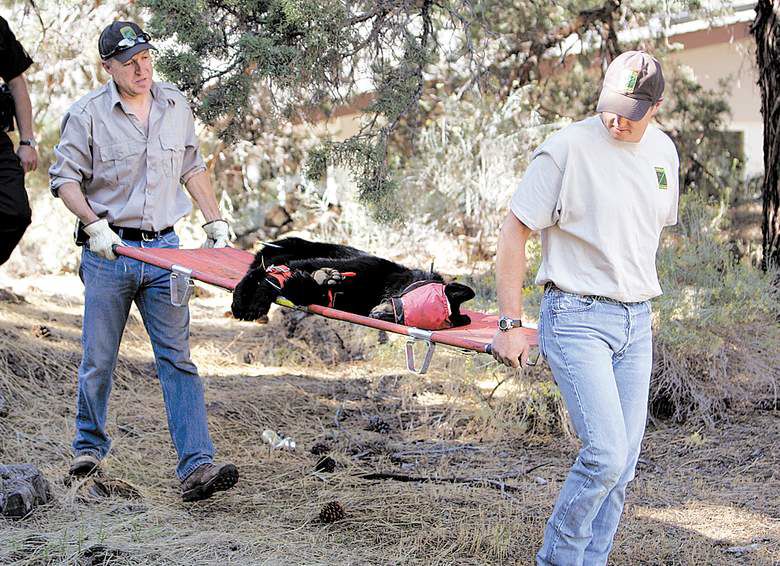Bear in Bend
Published 5:00 am Tuesday, September 28, 2010

- Wildlife biologist Corey Heath, left, and biologist Randy Lewis, both with the Oregon Department of Fish and Wildlife, carry a sedated male black bear to their truck. The bear was probably 15 or 16 months old, Heath said, and weighed about 50 pounds.
A young black bear spent several hours roaming the yards of a Southeast Bend neighborhood Monday morning, before wildlife biologists tranquilized the animal, tagged him and released him west of Crane Prairie Reservoir.
Calls about a bear crossing Knott Road started coming in around 7 a.m., said Canyon Davis, community service officer with Bend Police Department. Officers tracked the bear as it wandered around the Alpine Village area. It finally stopped to rest in the backyard of a house on Ambrosia Land, off of Country Club Drive.
Trending
“He’s been circling this area since 7 (a.m.),” Davis said.
With the bear settled in one place, Corey Heath, a wildlife biologist with the Oregon Department of Fish and Wildlife, prepared a tranquilizer dart with a cocktail of telazol, xylazine and ketamine.
Black bears are not very common in the Bend area, he said — they need berries, roots, and a range of habitat types. This part of Central Oregon doesn’t offer that diversity.
“We don’t have a lot because we don’t have great bear habitat,” he said.
But some bears do live west of U.S. Highway 97 and around the Newberry National Volcanic Monument area, Heath said. And young bears, especially young male bears, will leave the area where they were born to find a new territory of their own. So occasionally a bear will make an appearance in town.
“Animals travel, and sometimes end up where they shouldn’t be,” Heath said.
Trending
The last time he darted a bear in Bend was in 2007, he said.
Davis added that while the police department gets frequent calls about elk and deer tangled in fences or hammocks, he’s only responded to three or four bear reports in the last 12 years.
Bears that roam into one town get one chance, Heath said.
“If we felt he was a threat to human safety, if he was causing damage in the form of getting into garbage cans, he would have been put down,” he said.
But this bear didn’t cause any damage, so Heath used the tranquilizer gun.
The first dart didn’t put the bear under. It went into the skin of the bear’s neck, not the muscle. Heath loaded up a second tranquilizer dart and, aiming over a neighbors wood fence, shot the bear again.
That one had the desired effect.
“I saw him wobble and fall,” said neighbor Sharon Jones, who arrived home around 11 a.m. to find police and wildlife officials on her street.
But Jones said although it was “very cool and very unique” to see a bear in the neighborhood, it wasn’t a shock.
“I have a lot of strange animals that come in my yard, so it doesn’t really surprise me,” Jones said, noting that she’s spotted herons and a great horned owl, as well as a herd of eight or so deer that pass through on a little trail.
Once the bear was knocked out under a pine tree in a backyard, Heath and Randy Lewis, a biologist with the Oregon Department of Fish and Wildlife, restrained its legs and slipped a hood over its head.
The bear was a male, probably between 15 and 16 months old and about 50 pounds, Heath said — grown black bears are usually around 250 pounds. And the bear seemed in good health, even a little heavier than the biologists expected.
The biologists lifted the bear onto a stretcher and carried him to the driveway. They took out the darts, put on an ointment to prevent infections and checked the color of its gums to make sure it was getting enough oxygen. Then they slid it into the back of a Fish and Wildlife pickup.
The next stop for the bear was the Fish and Wildlife office, where it was tagged and put in a culvert trap, basically a large, solid pipe with gates at the end. It started to wake up as Heath drove it out to national forest lands southwest of Bend, and wandered off after it was released, Heath said.
“We try and take them as far away as we can, that is still suitable bear habitat where they won’t get into trouble,” Heath said.
What to do if you see a bear
If people see a bear in a residential area, they should stay away from the animal and call the police department, said Canyon Davis, community service officer with the Bend Police Department. They should try to keep track of where the animal is going, but only from within their house or car — don’t attempt to pursue the animal, Davis said.







